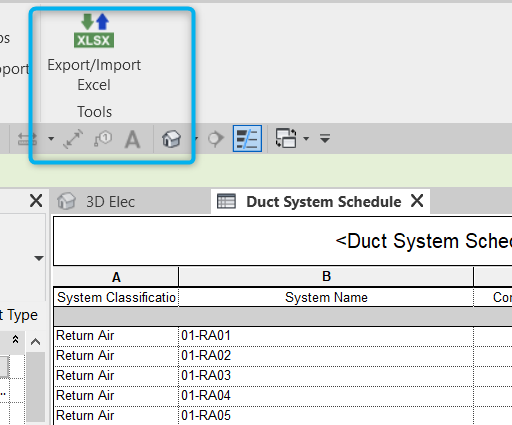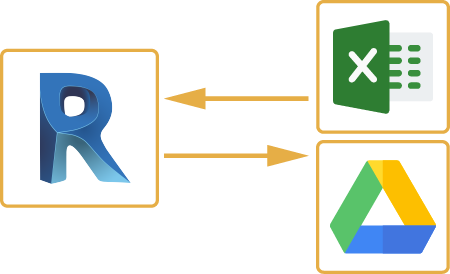Enhance Your Workflow with Powerful Revit Add Ins
Wiki Article
Damaging Obstacles: Excel Importation Techniques for Advanced Revit Users
Are you an innovative Revit customer seeking to take your skills to the following level? In this article, we will certainly show you exactly how to break obstacles by leveraging Excel for importation in Revit. Check out various information importation techniques and master Excel integration to boost your Revit modeling capacities. With our tricks and pointers, you can conquer importation challenges and come to be a true specialist in using Excel for your Revit tasks. Prepare to succeed in your Revit journey!Advanced Revit Users: Leveraging Excel for Importation
You can conveniently utilize Excel for importation as an innovative Revit user. Excel is a powerful tool that can greatly improve your operations and effectiveness in Revit. With its capacity to deal with huge amounts of data and do complex computations, Excel can be a beneficial possession in handling and organizing your job details.One way to take advantage of Excel for importation is by making use of the "Link Excel" feature in Revit. This function permits you to link an Excel spread sheet directly into your Revit job, allowing you to upgrade and synchronize information between the two programs. This can be specifically beneficial when taking care of schedules or tracking changes in your task.
An additional means to make use of Excel is by using the "Import/Export" feature in Revit. This attribute permits you to import and export information in between Revit and Excel, offering you the adaptability to collaborate with data in both programs. You can import data from Excel right into Revit to create elements such as spaces, doors, or walls, and you can additionally export information from Revit to Excel for more evaluation or reporting.

Exploring Information Importation Techniques in Revit Making Use Of Excel
Discovering just how to import information from Excel right into Revit provides effective techniques for incorporating info. When you import information from Excel, you can effortlessly move data such as space routines, material listings, and devices data into your Revit project. This procedure permits you to conserve effort and time by preventing hands-on data entrance.To import data from Excel right into Revit, you can use the "Import/Export" feature. This feature enables you to map the Excel information areas to the matching Revit specifications, making certain that the details is correctly designated within the design. By picking the suitable import options, you can regulate just how the information is imported and exactly how it engages with your job.
One more method for importing information from Excel into Revit is by using Dynamo. Dynamo is an aesthetic programs tool that incorporates with Revit and enables you to automate tasks and operations. With Eager beaver, you can create customized manuscripts that import data from Excel and manipulate it within your Revit task. This technique provides also much more adaptability and modification choices.
Grasping Excel Integration for Advanced Revit Modeling
Understanding Excel integration for innovative Revit modeling involves using reliable approaches to flawlessly transfer information and automate jobs within your job. By harnessing revit add ins the power of Excel, you can improve your Revit modeling operations and save useful time. One vital technique is importing data from Excel spread sheets directly right into your Revit design. This allows you to occupy criteria, such as space names or product quantities, easily. With a couple of easy actions, you can map the Excel columns to the equivalent Revit parameters and import the data properly.Another beneficial approach is exporting information from Revit to Excel. This enables you to extract info from your design, such as timetables or product quantities, and analyze it in Excel making use of formulas, charts, or other powerful tools. By leveraging the abilities of Excel, you can do intricate computations, create custom-made records, and gain beneficial understandings right into your task.
Along with information transfer, Excel integration can automate repetitive jobs in Revit. By developing macros or manuscripts in Excel, you can automate procedures like developing sights, creating sheets, or using standard families - revit add ins. This not just conserves time yet additionally ensures consistency throughout your task
To master Excel integration in Revit, it is essential to comprehend the information framework and exactly how Revit connects with Excel. By acquainting on your own with the offered tools and methods, you can unlock the complete possibility of Excel combination and take your Revit modeling to the next level.
Conquering Importation Difficulties: Excel Techniques for Revit Professionals
When getting over importation obstacles, it's crucial to be familiar with efficient Excel strategies that can profit experts in Revit. As an innovative Revit customer, you recognize the significance of perfectly importing data from Excel right into your jobs. You might experience numerous difficulties along the way. By using efficient Excel strategies, you can get over these obstacles and improve your productivity.
An additional valuable method is making use of the "Transpose" function in Excel. This enables you to transform data from rows to columns or vice versa. When importing information into Revit, this can be especially useful when you have information in an upright style in Excel, yet you require it to be in a horizontal layout in Revit.
Furthermore, using Excel solutions such as VLOOKUP and INDEX-MATCH can considerably aid in mapping data from Excel to Revit. These formulas allow you to look for specific values in Excel and retrieve corresponding data from one more column. This can conserve you time and effort when importing large datasets into Revit.
Excel Information Importation Tips and Techniques for Advanced Revit Users
By acquainting yourself with efficient Excel techniques and tips, you can enhance your data importation procedure as an innovative customer of Revit. Furthermore, utilizing Excel's "Paste Special" attribute permits you to paste information from Excel into Revit while keeping format, such as cell color or font style. An additional practical technique is to use Excel's "Find and Change" function to promptly make modifications to your data prior to importing it into Revit.
Conclusion
You have actually now discovered valuable methods for importing information from Excel into Revit as a sophisticated user. Go in advance, damage those obstacles and stand out in your Revit jobs!
When importing information into Revit, this can be specifically practical when you have information in a vertical style in Excel, yet you need it to be in a horizontal layout in Revit.
Additionally, using Excel solutions such as VLOOKUP and INDEX-MATCH can considerably help in mapping information from Excel to Revit. Additionally, utilizing Excel's "Paste Unique" attribute allows you to paste information from Excel right into Revit while keeping formatting, such as cell color or font design.
Report this wiki page